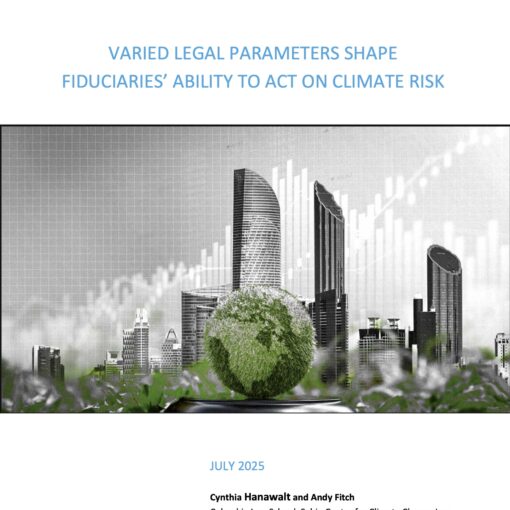Since President Biden took office in January 2021, his administration has been proactive in its efforts to fulfill his campaign promise to place climate issues at the forefront of his presidential agenda. Two executive orders, Executive Orders (EOs) 13990 and 14008, both issued within a week of President Biden’s inauguration, call for a whole-of-government and science-based approach to tackling the current and expected impacts of climate change on the U.S and its economy, infrastructure, and markets. Further embracing this presidential agenda, on May 20, 2021, President Biden issued EO 14030, entitled “Executive Order on Climate-Related Financial Risk”, the Biden administration’s declaration of policy on the possible incorporation of climate-related financial risk considerations into federal government regulations. The EO declares a new federal policy of “advanc[ing] consistent, clear, intelligible, comparable, and accurate disclosure of climate-related financial risk.” 
EOs 13990, 14008, and 14030 direct federal agencies, within the limits of their respective statutory authorities, to adopt regulations that aim to address the impacts of the climate crisis. The Chair of the Financial Stability Oversight Council (FSOC) was tasked under EO 14030 with assessing the impact of climate-related financial risk on the financial stability of the federal government and the U.S. financial system, facilitating the dissemination of climate-related financial risk data between and among FSOC member agencies and other executive agencies, and issuing a report on efforts by FSOC member agencies to integrate climate-related financial risk considerations in policies and programs. In its 2021 Report on Climate-Related Financial Risk (2021 FSOC Report), FSOC presented an initial assessment of the risks posed by climate change on the stability of the federal government and financial system, as well as efforts undertaken by member agencies to integrate climate-related financial risks into regulatory activities, enhance disclosure of climate risks and other relevant information. The 2021 FSOC Report recommended that member agencies review existing requirements and look into the possibility of updating relevant regulations to improve the assessment and mitigation of climate related financial risks, and promote the “consistency, comparability, and decision-usefulness” of publicly available information on climate risks and opportunities.
The issuance of EO 14030 and the 2021 FSOC Report spurred executive and regulatory activity, especially among financial, banking, and procurement regulators. Since the issuance of EO 14030 almost two years ago, the Securities and Exchange Commission (SEC), Federal Acquisition Regulatory Council (FAR Council), Office of the Comptroller of the Currency (OCC), Federal Reserve Board (FRB), and Federal Deposit Insurance Corporation (FDIC) (all of whom are FSOC member agencies) have proposed rules and/or guidance dealing with the assessment and disclosure of climate-related financial risk. Generally, the current slate of proposals focus on two types of climate-related financial risk:
- transition risks, which are associated with the transition to a lower-carbon global economy, the most common of which relate to policy and legal actions, technology changes, market responses, and reputational considerations; and
- physical risks which emanate from climate change, and which can be event-driven (acute) such as increased severity of extreme weather events (e.g., cyclones, droughts, floods, and fires) as well as longer-term shifts (chronic) in precipitation and temperature and increased variability in weather patterns (e.g., sea level rise).
These regulatory developments aim to address the impacts of physical and transition climate risks on almost every aspect of the markets and economy. Below is a summary of recent actions undertaken by the SEC, FAR Council, OCC, FRB, FDIC, as well as the Commodity Futures Trading Commission (CFTC).
Proposed Agency Rules; Requests for Information
One of the more noteworthy regulations, the SEC’s proposed rule, entitled “The Enhancement and Standardization of Climate-Related Disclosures for Investors” (SEC Proposed Rule), will, if finalized in its current form, require registrants to disclose key information on Scope 1, 2, and 3 emissions metrics, the physical climate risks to which their assets and operations are exposed, strategies for management of material climate-related financial risks, climate-related targets and goals, and any transition plans (if any) that are available to the business. In pushing for the inclusion of this type of information in the securities disclosure regime, the SEC aims to consolidate “consistent, comparable, and reliable” information on climate-related financial risk, and provide investors with “decision-useful” data to assess the impact of climate risks on the securities and capital markets.
The FAR Council has also released a proposed rule (FAR Proposed Rule) dealing with climate risk disclosures. The FAR Proposed Rule would, if adopted, require certain federal contractors to make climate-related disclosures and set emissions reduction targets. This would be achieved through amendment of the existing Federal Acquisition Regulation, the primary regulation governing executive agencies acquisition of supplies and services using appropriated funds. The FAR Proposed Rule divides federal contractors into two broad categories—“significant” and “major” contractors—and imposes different disclosure obligations on each. While both types of contractors will be required to disclose their Scope 1 and 2 emissions, only major contractors will need to disclose information on its Scope 3 emissions and climate-related financial risk, as well as set and disclose science-based emissions reduction targets. Noncompliance with the disclosure requirements could impact a contractors’ eligibility to bid for procurement contracts.
Both the SEC and FAR Proposed Rules utilize existing reporting mechanisms for their respective disclosure requirements. These include the GHG Protocol Corporate Accounting and Reporting Standard (GHG Protocol), the 2017 Recommendations of the Task Force on Climate-Related Financial Disclosures (TCFD) and the 2021 TCFD Annex: Implementing the Recommendations of the TCFD (collectively, TCFD Recommendations), the CDP Climate Change Questionnaire, and the Science-Based Target Initiative (SBTi). The SEC Proposed Rule focuses on the methodologies in the GHG Protocol and TCFD Recommendations, while the FAR Proposed Rule also makes use of the reporting mechanisms in the CDP Climate Change Questionnaire and the SBTi. The SEC and FAR Council acknowledge the challenges covered entities may face while adjusting to these new reporting requirements, so both rules include a phase-in period to ease compliance burdens. Both agencies received significant substantive feedback from stakeholders on the language and requirements of the Proposed Rules during their respective comment periods, which closed in mid-2022 (for the SEC Proposed Rule) and in early 2023 (for the FAR Proposed Rule).
The CFTC also recently invited interested parties to weigh in on their understanding and oversight of climate-related financial risks in the commodity, futures, and derivative markets. The agency published a Request for Information (RFI) to receive public responses from stakeholders on how the agency could best utilize its oversight authority to ensure the integrity of commodity and derivative transactions, and to avoid systemic risk. The CFTC’s RFI period closed in October 2022. On March 7, 2023, CFTC Commissioner Christy Goldsmith Romero proposed that the agency formulate a new framework to identify environmental- and/or climate-related products trading in the derivative markets, suggesting that climate-related financial risks are on the agency’s radar.
Draft banking guidance
The banking regulators have also been proactive in efforts to integrate climate-related financial risk considerations into banking regulations. OCC released draft Principles for Climate-Related Financial Risk Management for Large Banks in 2021, FDIC published its draft Statement of Principles for Climate-Related Financial Risk Management for Large Financial Institutions in mid-2022, and FRB proposed its own draft Principles for Climate-Related Financial Risk Management for Large Financial Institutions in late 2022 (collectively, Draft Principles).
Notably, the language of all three Draft Principles essentially mirror one another, perhaps to encourage the standardization of the framework. All three banking agencies identify climate change and the energy transition as emerging risks to the banking and financial systems, and recognize that existing and possible weaknesses in the identification, assessment, management, and mitigation of physical and transition risks could negatively impact a bank’s safety and soundness. Thus, all three Draft Principles provide a high-level framework for the management by large banks of climate risk exposures and the integration of climate-related financial risk considerations into banks’ risk management mechanisms. However, the Draft Principles only apply to large financial institutions with over $100 billion in total consolidated assets. Moreover, the Draft Principles provide only recommendations, and large banks are not required to incorporate the suggested framework into their risk management processes.
What now?
None of the proposed rules or draft principles discussed above have been finalized so far. The SEC Proposed Rule has garnered significant media and legal commentary since its release in early 2022, and questions remain on whether the agency will retain or revise the current language of the requirements in a final rule. The FAR Proposed Rule has also been criticized as inappropriate; advocates have countered this by expressing support in favor of the FAR Proposed Rule, arguing that the regulation falls well-within the FAR Council’s regulatory mandate, and that it has the potential to drive sustainability in global supply chains.
Assuming the SEC’s and FAR Council’s Proposed Rules are finalized before the year ends, the language of these final rules could set the tone for how other agencies might frame their own regulatory frameworks moving forward. The regulators may stand their ground finalize the proposed rules as they are presently worded, or they may change course in an effort to decrease litigation risk and avoid questions on the breadth of their statutory authority. In any case, there is still reason to believe that this evolution in the relationship between financial regulation and climate risk can be productive and impactful. The recent proliferation of these proposed rules and guidance on the intersection of these two issues has provided many advocates, activists, and academics with an opportunity to engage with regulators on the best ways forward regarding the use of existing statutory authorities, and also highlight the availability of various science- and economic-based tools and models that could positively support a robust and reliable climate disclosure and risk management regime. If anything, these developments highlight that the U.S. legal framework does have the capacity to integrate climate risk considerations into federal rulemaking, and that the Biden administration continues to push forward towards achieving impactful science-based climate goals. Change is indeed the air—but it may take some time to see some real action.
The Sabin Center has been active in its efforts to highlight the value of these proposals and their positive impact on the U.S.’ climate agenda—you can view our comments on the SEC Proposed Rule here, CFTC’s RFI here, and the FAR Proposed Rule here and here.
Dyan is a Fellow at the Sabin Center for Climate Change Law. Her work and research focus on climate risk and resilience.





